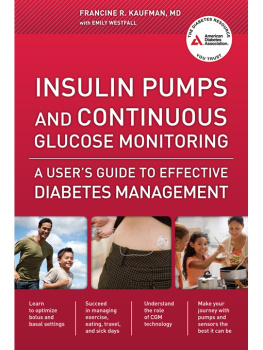
Director, Book Publishing, Abe Ogden; Managing Editor, Greg Guthrie; Acquisitions Editor, Victor Van Beuren; Editor, Greg Guthrie; Production Manager, Melissa Sprott; Composition, Naylor Design, Inc.; Cover Design, Vis--vis Creative Concepts, Inc.; Illustrators, KTB Studios, LLC, and Jeff Johnston; Printer, Versa Press.
2012 by the American Diabetes Association, Inc. All Rights Reserved. No part of this publication may be reproduced or transmitted in any form or by any means, electronic or mechanical, including duplication, recording, or any information storage and retrieval system, without the prior written permission of the American Diabetes Association.
Printed in the United States of America
1 3 5 7 9 10 8 6 4 2
The suggestions and information contained in this publication are generally consistent with the Clinical Practice Recommendations and other policies of the American Diabetes Association, but they do not represent the policy or position of the Association or any of its boards or committees. Reasonable steps have been taken to ensure the accuracy of the information presented. However, the American Diabetes Association cannot ensure the safety or efficacy of any product or service described in this publication. Individuals are advised to consult a physician or other appropriate health care professional before undertaking any diet or exercise program or taking any medication referred to in this publication. Professionals must use and apply their own professional judgment, experience, and training and should not rely solely on the information contained in this publication before prescribing any diet, exercise, or medication. The American Diabetes Associationits officers, directors, employees, volunteers, and membersassumes no responsibility or liability for personal or other injury, loss, or damage that may result from the suggestions or information in this publication.
 The paper in this publication meets the requirements of the ANSI Standard Z39.48-1992 (permanence of paper).
The paper in this publication meets the requirements of the ANSI Standard Z39.48-1992 (permanence of paper).
ADA titles may be purchased for business or promotional use or for special sales.
To purchase more than 50 copies of this book at a discount, or for custom editions of this book with your logo, contact the American Diabetes Association at the address below, at booksales@diabetes.org, or by calling 703-299-2046.
American Diabetes Association
1701 North Beauregard Street
Alexandria, Virginia 22311
DOI: 10.2337/9781580404617
Library of Congress Cataloging-in-Publication Data
Kaufman, Francine Ratner.
Insulin pumps and continuous glucose monitoring / Francine R. Kaufman, with Emily Westfall. 1st ed.
p. cm.
Includes bibliographical references and index.
ISBN 978-1-58040-461-7 (alk. paper)
1. Insulin pumps. 2. DiabetesTreatment. 3. InsulinTherapeutic use. 4. Blood sugar monitoring. 5. Patient education. I. Westfall, Emily. II. American Diabetes Association. III. Title.
RC661.I63K38 2012
616.462061dc23
2011050394
eISBN: 978-1-58040-499-0
CONTENTS
I would like to acknowledge the contribution that Dr. Harry Keen made to the field of insulin pump therapy. Harry gave birth to the notion and was visionary in realizing what it could do to improve the lives of those dependent on exogenous insulin treatment. I would also like to acknowledge all that Dr. John Pickup has done to help bring pump therapy to life.
I would like to thank Talia Rabb, who helped me conceive of how to frame this book. I would also like to thank Kelly Joy, Linda Burkett, Kathy Beaver, and Susan Bristol. Their advice and editing were invaluable.
I met Emily Westfall by serendipity on a plane. During that brief encounter, I was so impressed (and in need of help with organizing this book) that I asked her if she wanted to assist me. She was an amazing collaborator, and I am grateful she sat next to me and said yes to my request.
As always, my inspiration comes from my patients and their families, along with my husband, Neal Kaufman, MD, and my own children.
I remember the first insulin pump I used with my patients in the early 1980s. It was jokingly referred to as the big blue brick, and it weighed several pounds. The insulin-filled syringe was on the outside of the pump, the pump used a butterfly needle (the needle commonly used for intravenous delivery of medications) placed in the subcutaneous tissue, and, for the most part, it could only be used in the hospital setting. I remember feeling that this was a great advance for my patients, and I appreciated that they benefited from the continuous delivery of basal insulin and from the intermittent boluses that were given to match their food intake and to correct an abnormal blood glucose level when indicated. When I reflect back, I realize we have come a long way over the ensuing 30 years. We have witnessed incredible advances in the understanding of what happens to the cells of the body as the result of the diabetes process. We have seen tremendous breakthroughs in diabetes drug discovery, including the development of insulin analogs, and rapid advances in glucose monitoring technology. We have determined better ways to deliver diabetes education and support, and we continue to combat discrimination against people with diabetes. And most importantly for this book, today we have insulin pumps that are small, fast, and smart, and we have continuous glucose monitors (CGMs). CGMs can give information in real time to help with diabetes management decisions. With some devices, the pump and the CGM work together in a single system.
When I diagnose someone with diabetes, I feel as if I start him or her on a new, different lifes journey. To succeed on that journey, one must effectively manage diabetes so that the maximal amount of time is spent with glucose levels in the target range, and the minimum amount of time in the low or high range. To accomplish this, people with diabetes, and their parents or caregivers, must track glucose levels to be able to deliver insulin in a manner that closely resembles how the body produces and uses its own insulin. Often the best way to achieve this is to use an insulin pump. And this may be accompanied by using a CGM. These technologiesalthough not really that much more complicated than your smartphone, computer, or DVDdo require basic understanding, training, and follow-up adjustment if they are going to be helpful in improving diabetes outcomes. The purpose of this book is to give you practical tips, including the knowledge and the skills to maximize insulin pump therapy and continuous glucose monitoring, if that is what you and your health care provider decide is best for you or your child. The goal is to enable you to make your journey through life with diabetes as successful as possible.
The goal of section 1 is to review the basic physiology of glucose control and what occurs when someone has diabetes. To understand what you are striving for, you must also be aware of glucose and A1C targets. The central principles of how diabetes is now managed are supported by a series of important research studies. The critical ones, such as the Diabetes Control and Complications Trial (DCCT) and important research studies concerning insulin pump therapy, are reviewed so that you understand the evidence surrounding the recommendations for meticulous diabetes control.
The insulin pump is a small mechanical device worn by someone who has diabetes and who is treated with insulin. The insulin pump helps facilitate diabetes control and lifestyle flexibility. Insulin enters the body from the pump after flowing down the tubing into a small cannula, which is a soft tube, or through a small needle placed under the skin. Newer pumps dont even use tubing. The insulin regimen used by insulin pumps is called basal-bolus therapy, and the benefits of basal-bolus therapy will be outlined. In addition, youll see how you can balance insulin administration, food, and activity with greater ease while using an insulin pump.
Next page











 The paper in this publication meets the requirements of the ANSI Standard Z39.48-1992 (permanence of paper).
The paper in this publication meets the requirements of the ANSI Standard Z39.48-1992 (permanence of paper).